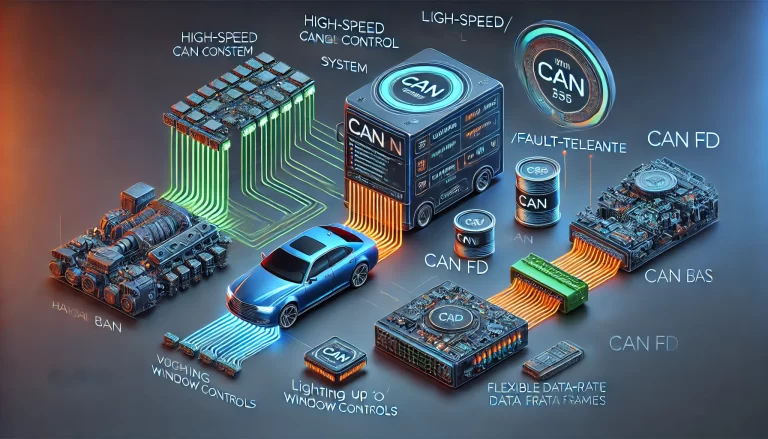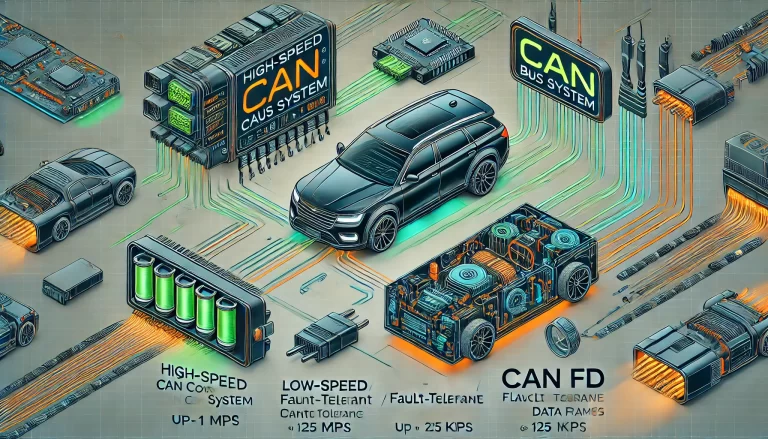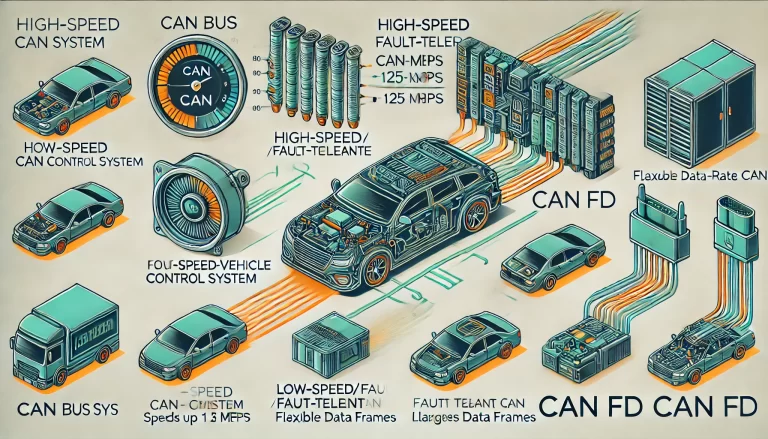The Controller Area Network (CAN) bus is a robust and widely used communication protocol, especially in automotive and industrial environments. It was originally developed to enable microcontrollers and devices to communicate with each other without the need for a host computer. Over the years, several variations of CAN bus systems have been developed to meet different application requirements. These include High-Speed CAN, Low-Speed CAN (also known as Fault-Tolerant CAN), and CAN FD (Flexible Data-rate). Each of these has unique characteristics, making them suitable for specific use cases.
Let’s dive deeper into each type:

1. High-Speed CAN (Classical CAN)
- Data Rate: Up to 1 Mbps.
- Use Cases: Automotive control systems, industrial automation, medical equipment, and aviation systems.
High-Speed CAN, often referred to as Classical CAN, is the original and most widely used form of the CAN protocol. It can support a maximum transmission speed of 1 Mbps, making it suitable for applications that require fast, real-time data exchange. In vehicles, it is typically used for critical systems such as engine control units (ECUs), Anti-lock Braking Systems (ABS), and transmission control units, where high data rates and minimal latency are essential.
One of the strengths of High-Speed CAN is its ability to operate in noisy environments, such as within vehicles. The differential signaling used in CAN communication reduces noise interference, ensuring reliable data transmission even in harsh conditions.
2. Low-Speed/Fault-Tolerant CAN
- Data Rate: Up to 125 kbps.
- Use Cases: Body control systems in vehicles, low-speed sensor networks, lighting control.
Low-Speed CAN, also known as Fault-Tolerant CAN, is designed for applications where communication speed is less critical, but fault tolerance is essential. The maximum data rate of Low-Speed CAN is 125 kbps, making it much slower than High-Speed CAN. However, it has the unique ability to continue operating even if one of the communication lines is interrupted. This is achieved through redundant wiring, ensuring that the system can still function in the event of a failure in the network.
In vehicles, Low-Speed CAN is often used for non-critical functions, such as window controls, seat adjustments, climate control, and lighting. These systems do not require high-speed communication but must remain operational even if there is a fault, making Fault-Tolerant CAN a good fit.

3. CAN FD (Flexible Data-Rate CAN)
- Data Rate: Up to 8 Mbps for the data phase.
- Use Cases: Advanced driver-assistance systems (ADAS), autonomous driving, infotainment, and diagnostic systems.
CAN FD is an enhanced version of the Classical CAN protocol, designed to accommodate the increasing demands for higher data throughput in modern applications. One of the key differences in CAN FD is that it allows for more flexible data transmission rates. While the arbitration phase (the initial phase where nodes compete for access to the bus) still operates at the standard CAN speed of up to 1 Mbps, the data phase can reach speeds of up to 8 Mbps.
In addition to the faster data rates, CAN FD supports longer data frames—up to 64 bytes compared to the 8 bytes allowed by Classical CAN. This enables more data to be transmitted in a single frame, which is particularly useful for applications like autonomous driving, where vast amounts of sensor data need to be exchanged rapidly.
CAN FD is backward-compatible with Classical CAN, meaning that it can coexist on the same network as Classical CAN nodes, as long as the Classical CAN devices are not required to interpret the extended data frames.

Choosing the Right CAN Bus System
When selecting the appropriate CAN bus system for a particular application, several factors must be considered, including data rate, fault tolerance, and the criticality of the system.
For real-time, high-speed communication: High-Speed CAN is ideal for applications that require fast and reliable communication, such as engine management or safety-critical systems like airbags or ABS in vehicles.
For fault-tolerant systems with less demanding speed requirements: Low-Speed CAN is perfect for vehicle body systems, where maintaining operation in the event of a fault is more important than data transmission speed.
For high-performance applications requiring faster data transfer: CAN FD is the best choice, especially for advanced systems like autonomous driving or high-resolution infotainment systems, where large amounts of data must be transmitted quickly and efficiently.

Conclusion
The CAN bus system, with its various types—High-Speed CAN, Low-Speed/Fault-Tolerant CAN, and CAN FD—offers a flexible and robust communication solution for a wide range of applications. Whether it’s critical real-time data exchange in automotive systems or fault-tolerant communication in low-speed networks, CAN bus continues to play a vital role in modern electronics and control systems. With the introduction of CAN FD, the protocol has evolved to meet the growing data demands of today’s high-performance applications, ensuring its relevance for years to come.
